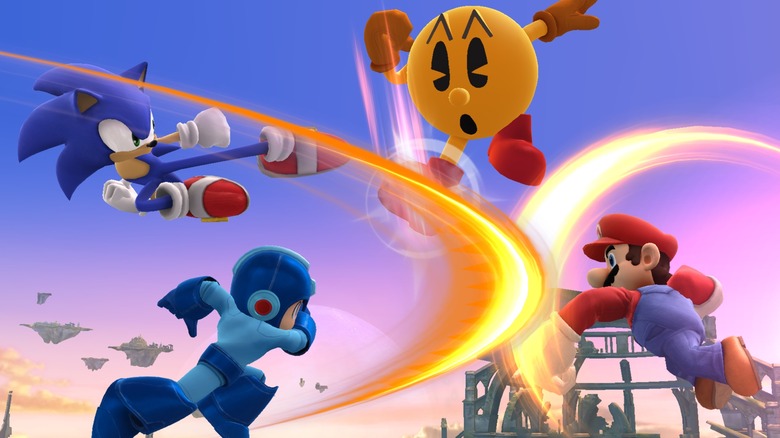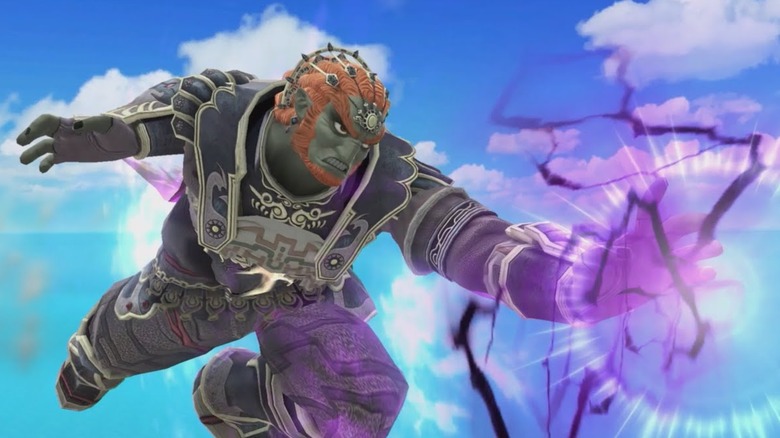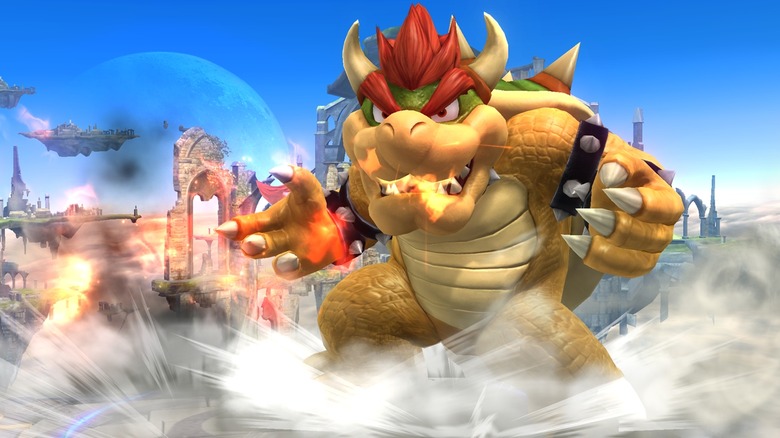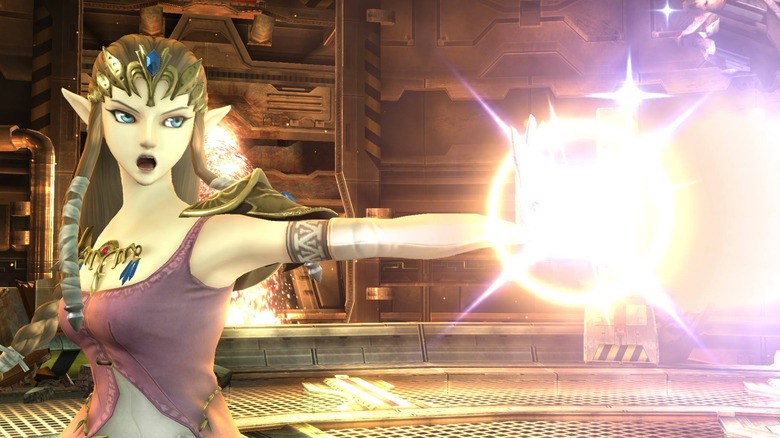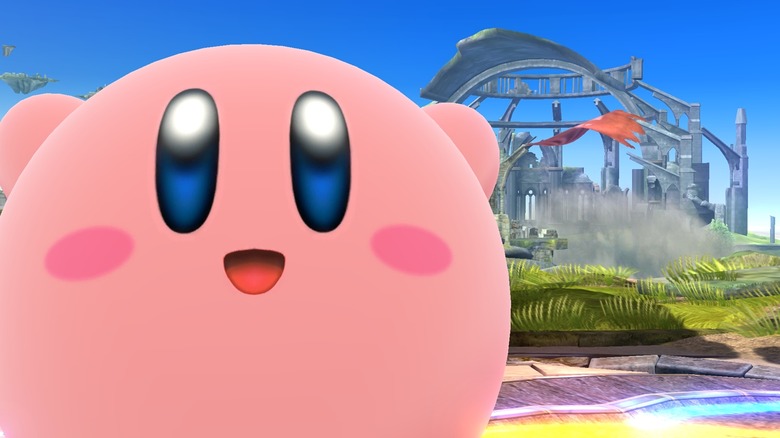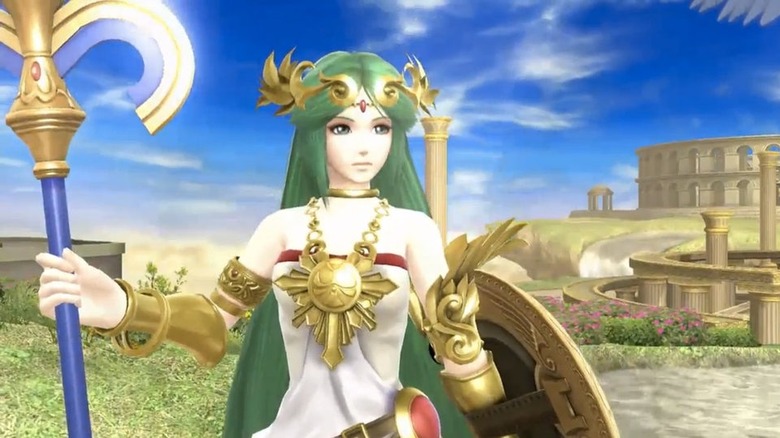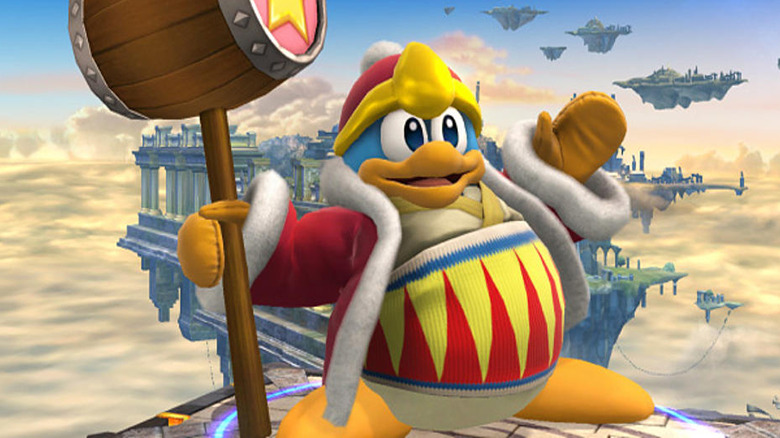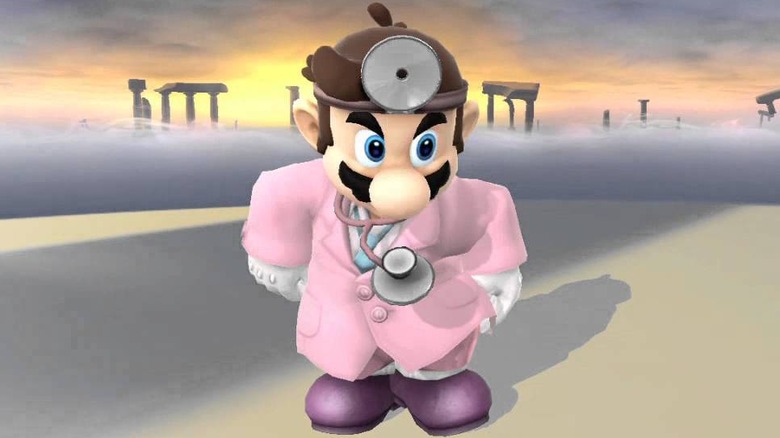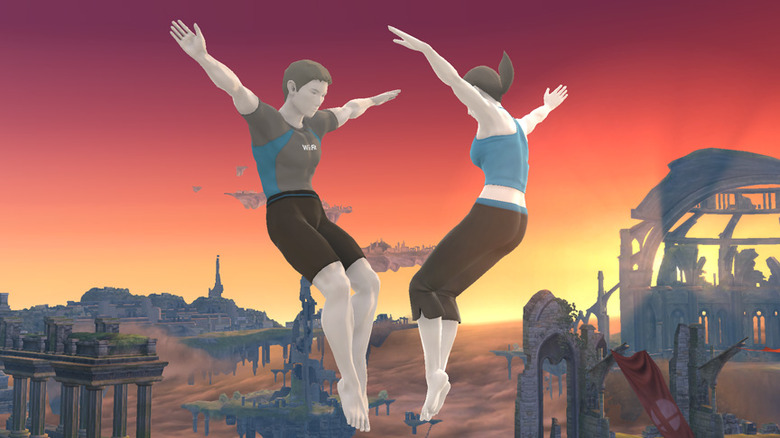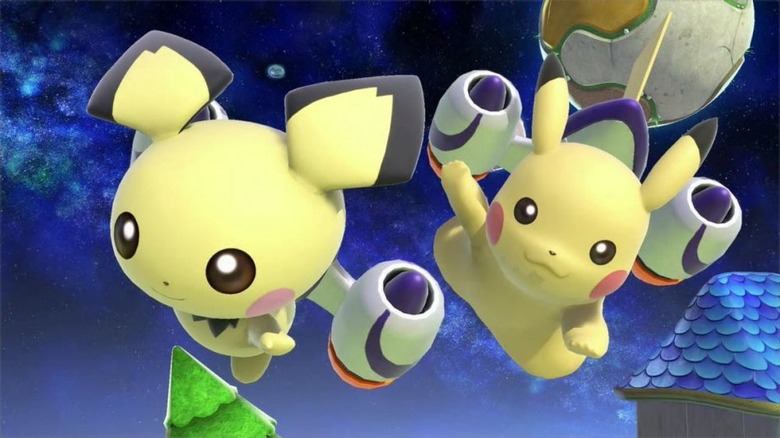The Worst Characters In The History Of Smash Bros.
The Super Smash Bros. fighting game franchise has long been a staple of Nintendo's first-party lineup, thanks to its incredible cast of characters and easy to pick up, hard to master gameplay. Given the series' accessible nature and ultra-inclusive roster that plucks characters from all across Nintendo's history, as well as a few cameo characters from other companies' properties, it makes sense that the games are geared more towards fun than balance. And for most players, that's okay — to a lot of people, Smash is just about throwing down with friends while playing as your favorite gaming icons. But given Smash Bros.' huge competitive scene, this means that, at higher levels of play, some characters are flat-out persona non grata because they can't hold their own.
We've rounded up this list to go over the series' most consistently underpowered characters, the most ineffectual in Smash Bros.' history. Though these characters might be fun to play as casually or linked to your favorite franchises, none of them hold up when scrutinized for real competitive play. Read on to see who's among the worst.
Ganondorf
Of all the characters on this list, none are closer to being good than Ganondorf, if only because he's ridiculously strong and fairly heavy, meaning he can dish out a lot of damage and absorb just as much without jeopardizing his own safety. However, aside from being a serious damage dealer and attack sponge, he's got few tools to operate with. His weight comes at the cost of speed, leaving him as one of the slowest characters in the series, and it also forces Ganon to contend with gravity, leaving his jumps short and stunted. This wouldn't be the end of the world if he had a great up-B recovery move, but he doesn't; his recovery move has mediocre range which, when coupled with his weak jumping height, means that if a character can knock him off a stage, he's going to have a harder time than most getting back on. That's a massive pitfall in a series with competitive play that emphasizes edge guarding (the act of stopping players from grabbing a stage's edge to get back on).
To further weaken Ganondorf's competitive prospects, his stronger moves telegraph themselves quite a bit, giving foes ample time to get out of the way. That means, for all his strength, the effect of Ganon landing a hit will likely even out with the effect of an opponent scoring multiple weaker hits. To think, with just a few tweaks to his recovery range and attack speed, Ganondorf could be great. Alas.
Bowser
Bowser, across all the Smash games he's been in since Super Smash Bros. Melee, has never been a good enough character to score a seat at the competitive table. He's not very fast and has little attack range or neutral game. Neutral game refers to how good a character is at breaking through an enemy's defense and landing a hit when neither player has any sort of environmental or logistical advantage. For example, if Bowser and Sonic the Hedgehog are plopped on a flat stage with no hazards, Bowser is dangerously outmatched. Sonic can accelerate extremely fast, enter a spindash and change speeds and positioning on a dime, making it hard for a player to predict and block his attacks or punish him for a failed attack. Bowser has no ability to rival this. He can stomp on over to a foe and take a swipe at them with his stubby arms, but his moves are so easily telegraphed and lacking in range that he'll never get the jump on a good player or neutral-friendly character like Sonic.
Worse, most of Bowser's attacks leave him exposed for quite a few frames, meaning any character that dodges his attacks has a good window of time to get revenge and sock him. Bowser's special moves leave him especially exposed. While he does have a few fun tricks like his kamikaze body slam attack, he's terribly under-equipped for fast-paced competitive play.
Zelda
Before we dive into why Zelda is a weak fighter in the Smash Bros. series, we have to clarify that we're not including her Sheik transformation from Melee and Brawl, for two main reasons: firstly, because she can change at will (unlike, say, Samus in Brawl, whose transformation is inextricably linked to her playstyle), and because tournament pros and character tier lists almost always rank Zelda and Sheik separately in terms of competitive viability. They're ranked so differently because, while Sheik has a great neutral game and plenty of speed, along with other valuable utilities, Zelda has relatively little to offer.
When it comes to weaknesses, Zelda's are many. She's a tall character, as opposed to fighters like Pikachu or Kirby, meaning she's got a lot of hitboxes for enemies to knock her around with. Couple this with her lightweight frame and it's undeniable that she's a fighter who's easy to rack up damage on and KO fairly quickly. Given her weight and height, one would hope she's fast — but she's not. She's too slow to balance out her physical shortcomings. Worse, her attacks are (generally speaking) easily dodgeable, and many of them have underwhelming ranges and hitboxes, meaning she's got little in the way of reliable offensive options. While she does have the potential to deal out good damage with her handful of combo options, that's not enough to save her from competitive irrelevancy.
Kirby
Though Kirby was a solid pick back in the original Super Smash Bros. game for the Nintendo 64, every entry in the franchise since has made him a laughing stock. Though his moveset is entertaining to watch and serviceable for casual play, he's got several major shortcomings that ensure he virtually never appears in a competitive setting.
First and foremost, his weight and physics: he's light as a feather, meaning not only can he be KO'd super quickly, but it also means his floaty jumps last (almost) forever, leaving him exposed during aerial maneuvers for much longer than most other characters. In this sense, he's little more than a pink punching bag. This is doubly true when you analyze his offensive options, which offer him little horizontal control over enemies. Though his multiple jumps, up-B attack, and down-B attack afford him some interesting options when dealing with enemies above or below him, none of his attacks give him any noteworthy control over his sides, meaning any enemy with ranged attacks or horizontal special moves with big reach can pin Kirby down easily.
Kirby's only real competitive edge is his standard B-button attack, which sucks enemies in, absorbs their standard B-attack (enabling Kirby to use it), then spits them out. Some players use the spit range of this attack to launch swallowed foes into stage hazards for instant KOs. Still, this cute trick doesn't make up for nearly enough of Kirby's shortcomings.
Palutena
As far as the worst characters in Smash history go, Palutena's a unique addition thanks to the peculiar circumstances that make her bad. First, most of her attacks have a strange amount of visual lag, meaning after you input a move, the time between your command processing, the animation starting, and the attack fully executing is really long, especially compared to most other characters. Because of this attack delay, you essentially have to read your opponent's mind a full second in advance in order for most of Palutena's attacks to land. You also have to read your opponent's mind in order for half of Palutena's special moves to be relevant, as she's primarily a defensive character who banks on reflection and counter-attacks. These moves are only useful if you time them perfectly in sync with an enemy's attack, leaving Palutena as a reactive character rather than a proactive one.
This dearth of offensive options, coupled with her unsavory slowness, leaves her as little more than a fan-service character for Kid Icarus fans. She also makes for a semi-viable troll character in team battles, wherein she can play mind games with the opponent while serving as a sentient shield for her teammate.
King Dedede
When it comes to fighting capabilities, King Dedede has little to offer. You'd think with that massive mallet of his he'd pack quite the punch and at least be a damage powerhouse. Sadly, that's not the case. While he can output some good damage, it's just not comparable to the other fellows in his weight range, such as Bowser and Ganondorf. This means he can't KO opponents at low enough percentages to balance out his many weaknesses: his ridiculous size and the accompanying massive hitboxes that make him (arguably) the easiest Smash character to land a hit on. This, coupled with his low speed when jumping and high speed when falling, makes it easy for opponents to trap him in brutal juggles and combos anytime he leaves the ground.
Even his offense is defensively weak, since his stronger attacks require precious time to execute that a massive target like him just can't afford. While he had some decent strategies revolving around his grab moves in Brawl, that's not the case in Super Smash Bros. for Wii U, which takes away one of the few tools he had. Still, Dedede was never good. Smash Wii U just helped demystify why it briefly seemed like he wasn't so bad.
Dr. Mario
If you played Super Smash Bros. Melee, you likely remember Dr. Mario as being a decent choice. These days, he's anything but. While Dr. Mario isn't utter trash in Super Smash Bros. for Wii U, he's still among the least desirable characters on this list for one major reason: he's a mediocre clone of a much better character. Dr. Mario is worse than Mario in most ways, and though said weaknesses are small by themselves, the sheer number of them amounts to a less appealing character. First, Dr. Mario's basic jump height is shorter than Mario's, as is his up-B recovery move. On top of that, his movement speed is slower than Mario's. Also, his side-B cape ability has less utility than Mario's, which acts as a sort of bonus recovery move for the latter thanks to its movement properties. Dr. Mario also has less combo potential thanks to his moves' damage outputs and knockback capabilities, making it much harder to keep an enemy in range to string together attacks.
These weaknesses keep Dr. Mario in the shadow of his superior counterpart's blue overalls. Hence, if you're looking to escape casual play and go pro, regular Mario is the mustachioed Italian for the job.
Wii Fit Trainer
Wii Fit Trainer is probably the strangest inclusion in all of Smash Bros. history. They (we're using this pronoun since the character can be either a man or a woman, depending on which variant you choose) use yoga and stretching positions to attack enemies. That attack style fares about as well as you'd expect in a game where other characters shoot fireballs and explosives.
Wii Fit Trainer's moveset just doesn't give them enough options to control the stage or have any sort of worthwhile neutral game. Their moves tend to have a short range or be bound by cardinal directions, which leaves enemies with a lot of angles to attack Trainer. Furthermore, Wii Fit Trainer lacks the tools necessary to produce good combos, meaning a lot of their attacks will be basic jabs and one-and-done special moves. Though Trainer has a healthy speed-to-weight-to-height ratio, their moveset just doesn't afford them enough stage control to stop them from being easily overpressured by most characters with any good neutral or rushing options.
Pichu
Pichu is more of a meme than a legitimate fighter. Having debuted in Melee (his one and only appearance on the series' roster besides Ultimate), Pichu is known for being a less reliable and competent version of Pikachu, the Pokemon he evolves into who happens to also be a fighter in Melee. Just as with the faceoff between Dr. Mario and Mario, most things the clone character Pichu can do, the original Pikachu can do better. Not to mention, Pichu is very lightweight, meaning he's even easier to knock around and KO than Pikachu. And, lest we forget his biggest flaw: his own electrical attacks injure him. If this sounds like a massive issue in a game all about minimizing damage taken, that's because it is.
While Pichu packs a bit of a punch thanks to some powerful attacks and aerial maneuvers, as well as a solid set of strategies revolving around his grab moves, these are just icing on a downright unappealing cake. Believe it or not, though, these flaws are deliberate attempts by the developers to handicap the character. According to a translation of Nintendo's very own Smash Bros. Dojo's Pichu page, he was designed to be the weakest character in Melee so that anyone who plays as him and wins will "look really cool." Only time will tell if any professional players will be willing to risk looking "really cool" with Pichu in Super Smash Bros. Ultimate's competitive scene.

